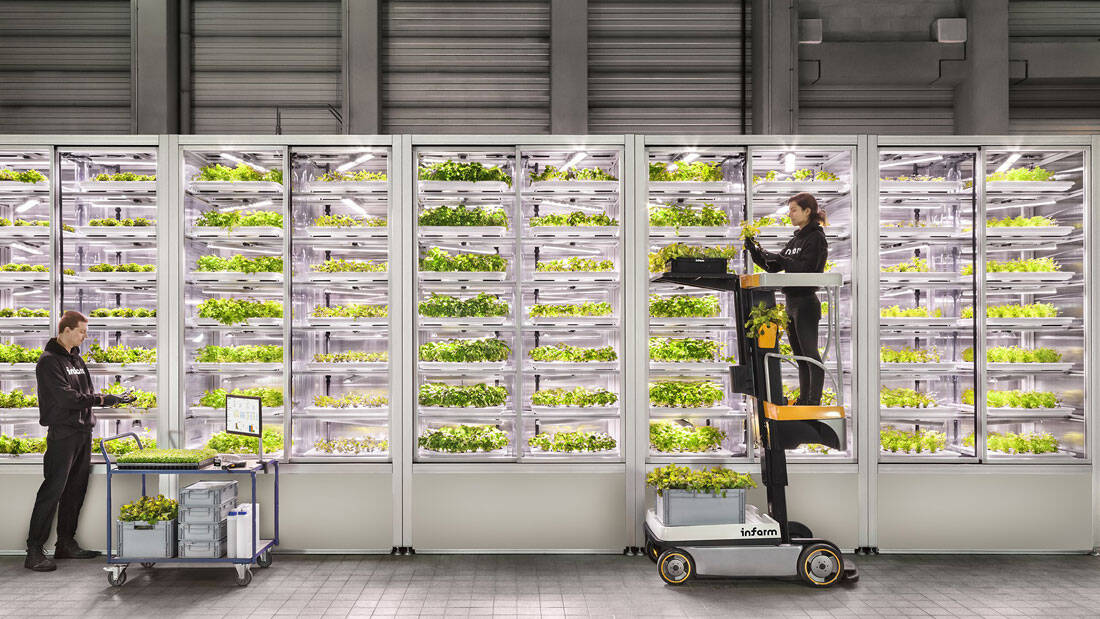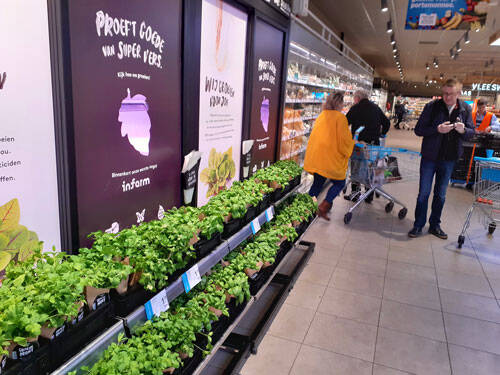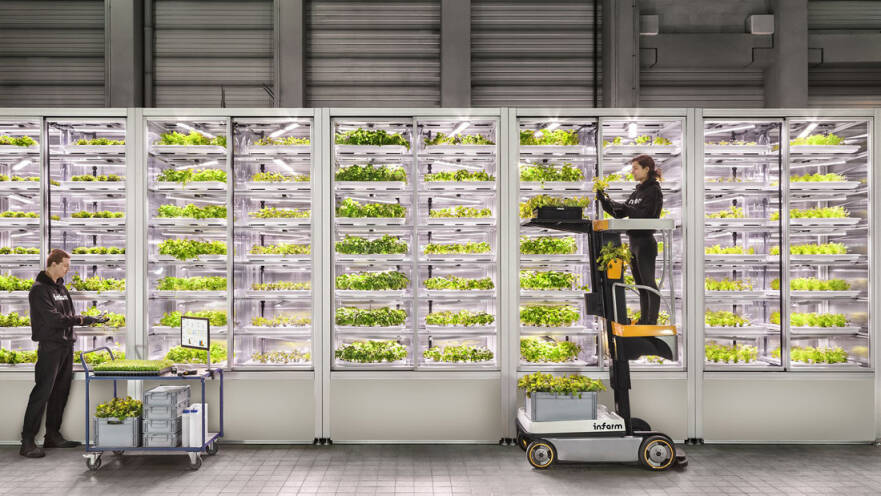RETHINKING THE FOOD CHAIN IN PRACTICE
Low and high tech solutions

These concepts are merely the tip of the iceberg in this vibrant space, and while either path may eventually lead to Rome, we are likely to need both when it comes to combating the monumental problems facing our planet and food system. It is important to remember that high tech and low tech approaches need not be mutually exclusive. If 2020 has taught us anything it’s that the best way forward is together.
High tech farm pods
German company InFarm radically shortens the food chain by integrating miniature farm pods directly into the fruits and vegetable aisle of supermarkets or restaurant kitchens. The company is active in the US and Europe and prides itself on using 95 percent less water, 75 percent less fertilizer, and 99 percent less space than traditional farms, all the while saving 90 percent on transportation. The farm pods can grow a variety of leafy greens and herbs. They’re still a ways off providing the variety we’ve grown accustomed to, but it’s hard to argue with the convenience. Especially considering each InFarm pod is controlled remotely through the cloud, and is able to make a myriad of tiny adjustments to ensure the best growth.
© InFarm-Nederland


© diephotodesigner.de

High tech anaerobic digester
Advanced technology made to serve in low tech areas is a popular avenue for reevaluating the food chain. The Waste Transformers do this by creating a containerized anaerobic digester, which can be planted anywhere to turn organic waste into clean energy and organic fertilizer. The biggest upside is the lack of technical knowledge required to operate the digesters, making them suitable for a wide range of uses. Recently the company partnered with IKEA to transform non-consumable food waste at their store in Haarlem, The Netherlands, into power and fertilizer for their food program.
Low tech shellfish farm
Hama Hama is a fifth generation shellfish farm on Washington’s Olympic Peninsula. In their own words their harvest schedule is set by planetary forces, and not corporate ones. Aquaculture like this is a potential path towards a better food chain. Creatures like oysters serve as natural filtrators that can help improve water quality and restore environmentally compromised ecosystems. When employed correctly aquaculture has the lowest greenhouse emissions of any animal food production. Hama Hama is additionally interesting because they are also involved in forestry. The forests serve as the nutrient base for their shellfish, and so taking good care of that part of nature is essential for both planet and business. 2020 also saw them successfully pivot to e-commerce in the wake of indefinite restaurant closures.

Low tech regenerative farm
Located in the Niigata Prefecture in Japan, in a small mountain village technically part of the city of Jōetsu, lies the Kuroiwa Permaculture Farm. Started by Emilio Garcia Barranco from Spain, this regenerative farm is a perfect example of the small scale, low tech approach towards rethinking the food chain. The farm has chickens, goats, ducks, and grows a variety of vegetables including corn and rice. Rather than the monolithic ranches we’re used to seeing, the Kuroiwa Permaculture Farm is made up of different tiny plots spread around the mountain village. The farm positions itself at the heart of the community, and locals often volunteer to help out. They have an active YouTube channel showing the growth and development of the project.
The need for a more sustainable and resilient food chain has been apparent for a while now, but the grand disruptions of 2020, chief among them the ongoing COVID-19 pandemic, have shone a harsh light on the inadequacies of our current system. When rethinking the food chain there are two dominant philosophies towards solving those shortcomings. For some it’s about embracing ancient, timeless techniques to reestablish harmony with nature, while for others the answers lie in new technologies and their applications. Here are 4 examples of these low and high tech approaches.
Jelle Steenbergen Xiao Er Kong
TRENDWATCH
3 min
rethinking the food chain in practice

These concepts are merely the tip of the iceberg in this vibrant space, and while either path may eventually lead to Rome, we are likely to need both when it comes to combating the monumental problems facing our planet and food system. It is important to remember that high tech and low tech approaches need not be mutually exclusive. If 2020 has taught us anything it’s that the best way forward is together.
© InFarm-Nederland


High tech farm pods
German company InFarm radically shortens the food chain by integrating miniature farm pods directly into the fruits and vegetable aisle of supermarkets or restaurant kitchens. The company is active in the US and Europe and prides itself on using 95 percent less water, 75 percent less fertilizer, and 99 percent less space than traditional farms, all the while saving 90 percent on transportation. The farm pods can grow a variety of leafy greens and herbs. They’re still a ways off providing the variety we’ve grown accustomed to, but it’s hard to argue with the convenience. Especially considering each InFarm pod is controlled remotely through the cloud, and is able to make a myriad of tiny adjustments to ensure the best growth.
© diephotodesigner.de

Low tech shellfish farm
Hama Hama is a fifth generation shellfish farm on Washington’s Olympic Peninsula. In their own words their harvest schedule is set by planetary forces, and not corporate ones. Aquaculture like this is a potential path towards a better food chain. Creatures like oysters serve as natural filtrators that can help improve water quality and restore environmentally compromised ecosystems. When employed correctly aquaculture has the lowest greenhouse emissions of any animal food production. Hama Hama is additionally interesting because they are also involved in forestry. The forests serve as the nutrient base for their shellfish, and so taking good care of that part of nature is essential for both planet and business. 2020 also saw them successfully pivot to e-commerce in the wake of indefinite restaurant closures.
High tech anaerobic digester
Advanced technology made to serve in low tech areas is a popular avenue for reevaluating the food chain. The Waste Transformers do this by creating a containerized anaerobic digester, which can be planted anywhere to turn organic waste into clean energy and organic fertilizer. The biggest upside is the lack of technical knowledge required to operate the digesters, making them suitable for a wide range of uses. Recently the company partnered with IKEA to transform non-consumable food waste at their store in Haarlem, The Netherlands, into power and fertilizer for their food program.

Low tech regenerative farm
Located in the Niigata Prefecture in Japan, in a small mountain village technically part of the city of Jōetsu, lies the Kuroiwa Permaculture Farm. Started by Emilio Garcia Barranco from Spain, this regenerative farm is a perfect example of the small scale, low tech approach towards rethinking the food chain. The farm has chickens, goats, ducks, and grows a variety of vegetables including corn and rice. Rather than the monolithic ranches we’re used to seeing, the Kuroiwa Permaculture Farm is made up of different tiny plots spread around the mountain village. The farm positions itself at the heart of the community, and locals often volunteer to help out. They have an active YouTube channel showing the growth and development of the project.
Low and high tech solutions
RETHINKING THE FOOD CHAIN IN PRACTICE
The need for a more sustainable and resilient food chain has been apparent for a while now, but the grand disruptions of 2020, chief among them the ongoing COVID-19 pandemic, have shone a harsh light on the inadequacies of our current system. When rethinking the food chain there are two dominant philosophies towards solving those shortcomings. For some it’s about embracing ancient, timeless techniques to reestablish harmony with nature, while for others the answers lie in new technologies and their applications. Here are 4 examples of these low and high tech approaches.
Jelle Steenbergen Xiao Er Kong
3 min










